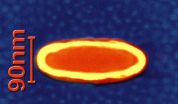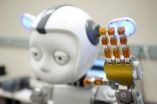(Press-News.org) This release is available in German.
Magnetic Random Access Memories (MRAM) are the most important new modules on the market of computer storage devices. Like the well known USB-sticks, they store information into static memory, but MRAM offer short access times and unlimited writing properties. Commercial MRAMs have been on the market since 2005. They are, however, still slower than the competitors they have among the volatile storage media. An invention made by the Physikalisch-Technische Bundesanstalt (PTB) changes this situation: A special chip connection, in association with dynamic triggering of the component, reduces the response from - so far - 2 ns to below 500 ps. This corresponds to a data rate of up to 2 GBit (instead of the approx. 400 MBit so far). Power consumption and the thermal load will be reduced, as well as the bit error rate. The European patent is just being granted this spring; the US patent was already granted in 2010. An industrial partner for further development and manufacturing such MRAMs under licence is still being searched for.
Fast computer storage chips like DRAM and SRAM (Dynamic and Static Random Access Memory) which are commonly used today, have one decisive disadvantage: in the case of an interruption of the power supply, the information stored on them is irrevocably lost. The MRAM promises to put an end to this. In the MRAM, the digital information is not stored in the form of an electric charge, but via the magnetic alignment of storage cells (magnetic spins). MRAMs are very universal storage chips because they allow - in addition to the non-volatile information storage - also faster access, a high integration density and an unlimited number of writing and reading cycles.
However, the current MRAM models are not yet fast enough to outperform the best competitors. The time for programming a magnetic bit amounts to approx. 2 ns. Whoever wants to speed this up, reaches certain limits which have something to do with the fundamental physical properties of magnetic storage cells: during the programming process, not only the desired storage cell is magnetically excited, but also a large number of other cells. These excitations – the so-called magnetic ringing – are only slightly attenuated, their decay can take up to approx. 2 ns, and during this time, no other cell of the MRAM chip can be programmed. As a result, the maximum clock rate of MRAM is, so far, limited to approx. 400 MHz. Until now, all experiments made to increase the velocity have led to intolerable write errors. Now, PTB scientists have optimized the MRAM design and integrated the so-called ballistic bit triggering which has also been developed at PTB. Here, the magnetic pulses which serve for the programming are selected in such a skilful way that the other cells in the MRAM are hardly magnetically excited at all. The pulse ensures that the magnetization of a cell which is to be switched performs half a precision rotation (180°), while a cell whose storage state is to remain unchanged performs a complete precision rotation (360°). In both cases, the magnetization is in the state of equilibrium after the magnetic pulse has decayed, and magnetic excitations do not occur any more.
This optimal bit triggering also works with ultra-short switching pulses with a duration below 500 ps. The maximum clock rates of the MRAM are, therefore, above 2 GHz. In addition, several bits can be programmed at the same time which would allow the effective write rate per bit to be increased again by more than one order. This invention allows clock rates to be achieved with MRAM which can compete with those of the fastest volatile storage components.
INFORMATION:
Contact at PTB:
Dr. Bernhard Smandek, PTB Technology Transfer, phone: +49(0)531 592-8303,
e-mail: bernhard.smandek@ptb.de
Extremely fast MRAM data storage within reach
Patented PTB invention solves the problem of 'magnetic ringing'
2011-03-09
ELSE PRESS RELEASES FROM THIS DATE:
How can robots get our attention?
2011-03-09
Getting someone's attention can be easy with a loud noise or a shout, but what if the situation calls for a little more tact? How can a robot use subtle cues to attract a human's notice and tell when it has captured it? In a preliminary study, researchers at the Georgia Institute of Technology have found that they can program a robot to understand when it gains a human's attention and when it falls short. The research is being presented today at the Human-Robot Interaction conference in Lausanne, Switzerland.
"The primary focus was trying to give Simon, our robot, the ...
Earth: Alive -- bacteria back from the brink
2011-03-09
Alexandria, VA – In 1993, "Jurassic Park" thrilled the world with the idea that dinosaurs could be resurrected from bits of DNA preserved in mosquitoes trapped in ancient amber. In the 18 years since the movie came out, scientists have been finding that parts of this scenario are closer to reality than anyone ever imagined: Researchers have found microbes living for tens of thousands - and maybe millions - of years inside salt crystals.
These findings raise exciting questions, as EARTH explores in "Bacteria Back From the Brink" in the April issue. Could these hibernating ...
Eating disorders and body dissatisfaction is double in Muslim teenagers than in Christian
2011-03-09
This release is available in Spanish and French.
The incidence of eating disorders was found to be 2.3-fold higher among Muslim adolescents than among their Christian classmates. Similarly, body dissatisfaction was 1.8-fold higher in the former group. Finally, as a general conclusion, an average of one in four adolescents suffers some type of eating disorder, and 15% suffers body dissatisfaction. These were the conclusions drawn of a research conducted at the University of Granada.
The sample was taken from a Spanish multicultural city, Ceuta, where different religious ...
Migrating moths and songbirds travel at similar rates
2011-03-09
A study published today (09 March) in Proceedings of the Royal Society B by researchers at Rothamsted Research (an institute of the Biotechnology and Biological Sciences Research Council), and the universities of Lund (Sweden), Greenwich and York, reports the surprising finding that night-flying moths are able to match their songbird counterparts for travel speed and direction during their annual migrations but they use quite different strategies to do so - information that adds to our understanding of the lifestyle of such insects, which are important for maintaining ...
University of South Florida researchers find blood-brain barrier damaged by disease
2011-03-09
A study into the effects of Sanfilippo Syndrome type B (MPS III B) has found that the barrier responsible for protecting the brain from the entry of harmful blood-borne substances is structurally and functionally damaged by the devastating disease. University of South Florida researchers identified damage in specific brain structures involved in the pathology of MPS III B, one of four Sanfilippo syndromes, all of which are inherited diseases of metabolism.
The study, using a mouse model of MPS III B, has been published online in the journal PLoS One. Before this study, ...
Cancer in HIV-positive patients
2011-03-09
Most HIV-positive patients die of cancer. In the latest issue of Deutsches Ärzteblatt International (Dtsch Arztebl Int 2011; 108[8]: 117), Manfred Hensel's research group presents epidemiological data.
The authors surveyed all German hospital outpatient clinics and ambulatory care centers specializing in the treatment of HIV patients in the period from 2000 to 2007 and were thus able to analyze the largest collection of data on the incidence of cancer in HIV patients ever assembled in Germany. It first became clear in the early 1980s that HIV infection is associated ...
Boston researchers create 'SMArt' platform architecture, launch $5,000 health app competition
2011-03-09
Boston, Mass. – Through a grant from the Office of the National Coordinator for Health Information Technology (ONC), researchers at Children's Hospital Boston and Harvard Medical School have developed a first-of-its kind platform architecture to support a flexible health information technology (IT) environment and promote innovation. The SMArt (Substitutable Medical Applications, reusable technologies) platform and interface are being made publicly available today to kick off the start of a $5,000 competition challenging developers to create web applications that provide ...
Research finds open-source software is actually more secure for health care IT
2011-03-09
Globally the sale of health care information systems is a multibillion dollar industry. The vast costs, frequent failed systems, and inability of systems to talk to each other regularly attract media comment. However policy makers still shy away from a class of software, Open Source, that could address many of these problems, because of worries about the safety and security of Open Source systems. Now new research by the University of Warwick's Institute for Digital Healthcare, and the Centre for Health Informatics and Multiprofessional Education at UCL Medical School, ...
Identifying 'anonymous' email authors
2011-03-09
Montreal, March 8, 2011 – A team of researchers from Concordia University has developed an effective new technique to determine the authorship of anonymous emails. Tests showed their method has a high level of accuracy – and unlike many other methods of ascertaining authorship, it can provide presentable evidence in courts of law. Findings on the new technique are published in the journal Digital Investigation.
"In the past few years, we've seen an alarming increase in the number of cybercrimes involving anonymous emails," says study co-author Benjamin Fung, a professor ...
Spanish tourists criticize other Mediterranean countries' lack of hospitality
2011-03-09
People visiting Spain have a high opinion of the price-quality ratio of Spanish hotels. Spanish tourists, on the contrary, complain about the quality of hotels, cleanliness and hospitality in countries such as Italy, Greece and France. This is one of the conclusions of a study carried out by the University of Cádiz (UCA) on tourism in southern Mediterranean countries.
"The five aspects most-highly rated by tourists travelling in the countries of the European Mediterranean are the leisure-spectacle activities, organised routes-excursions, cultural activities, the weather ...
LAST 30 PRESS RELEASES:
Making lighter work of calculating fluid and heat flow
Normalizing blood sugar can halve heart attack risk
Lowering blood sugar cuts heart attack risk in people with prediabetes
Study links genetic variants to risk of blinding eye disease in premature infants
Non-opioid ‘pain sponge’ therapy halts cartilage degeneration and relieves chronic pain
AI can pick up cultural values by mimicking how kids learn
China’s ecological redlines offer fast track to 30 x 30 global conservation goal
Invisible indoor threats: emerging household contaminants and their growing risks to human health
Adding antibody treatment to chemo boosts outcomes for children with rare cancer
Germline pathogenic variants among women without a history of breast cancer
Tanning beds triple melanoma risk, potentially causing broad DNA damage
Unique bond identified as key to viral infection speed
Indoor tanning makes youthful skin much older on a genetic level
Mouse model sheds new light on the causes and potential solutions to human GI problems linked to muscular dystrophy
The Journal of Nuclear Medicine ahead-of-print tip sheet: December 12, 2025
Smarter tools for peering into the microscopic world
Applications open for funding to conduct research in the Kinsey Institute archives
Global measure underestimates the severity of food insecurity
Child survivors of critical illness are missing out on timely follow up care
Risk-based vs annual breast cancer screening / the WISDOM randomized clinical trial
University of Toronto launches Electric Vehicle Innovation Ontario to accelerate advanced EV technologies and build Canada’s innovation advantage
Early relapse predicts poor outcomes in aggressive blood cancer
American College of Lifestyle Medicine applauds two CMS models aligned with lifestyle medicine practice and reimbursement
Clinical trial finds cannabis use not a barrier to quitting nicotine vaping
Supplemental nutrition assistance program policies and food insecurity
Switching immune cells to “night mode” could limit damage after a heart attack, study suggests
URI-based Global RIghts Project report spotlights continued troubling trends in worldwide inhumane treatment
Neutrophils are less aggressive at night, explaining why nighttime heart attacks cause less damage than daytime events
Menopausal hormone therapy may not pose breast cancer risk for women with BRCA mutations
Mobile health tool may improve quality of life for adolescent and young adult breast cancer survivors
[Press-News.org] Extremely fast MRAM data storage within reachPatented PTB invention solves the problem of 'magnetic ringing'



